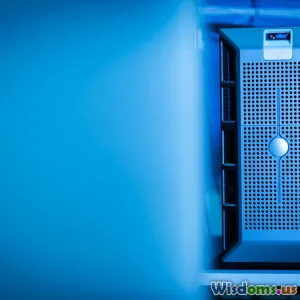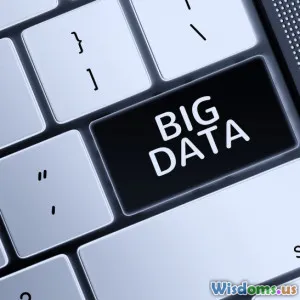
Ten Industry Innovations Powered By Distributed Computing
13 min read Explore ten cutting-edge industry innovations driven by distributed computing, revolutionizing sectors from healthcare to finance with efficiency, scale, and real-time solutions. (0 Reviews)
Ten Industry Innovations Powered By Distributed Computing
Today’s hyper-connected world thrives on solutions that harness vast amounts of data, process information in real time, and enable global collaboration. At the heart of this transformation is distributed computing—a paradigm where resources are spread across multiple locations but coordinated to solve complex tasks. Let’s explore ten groundbreaking industry innovations supercharged by distributed computing, complete with practical illustrations and real-world examples.
Revolutionising Financial Services With Blockchain Networks

Distributed computing has catalyzed a seismic shift in the financial sector—most prominently through blockchain technology. Unlike legacy systems that rely on centralized ledgers, blockchain’s distributed architecture secures transactions via a decentralized network of computers (nodes).
Visa and Mastercard now experiment with blockchain for cross-border payments, making them faster, more secure, and less reliant on a single authority. The 2008 launch of Bitcoin showcased how consensus protocols—achievable only in distributed setups—can enable trustless exchanges without a central bank.
A tangible recent example: JP Morgan’s JPM Coin operates on a distributed ledger to ease securities transactions among institutions. Fraud detection also benefits from distributed algorithms that monitor global transaction flows in real time, reducing response time to minutes instead of days.
Key takeaway: Distributed computing eradicates the weakest-link vulnerability in traditional financial infrastructure, enhancing both reliability and resilience.
Smarter Healthcare Systems Through Federated Learning

Healthcare’s digital transformation faces a unique problem: the privacy of sensitive patient data. Distributed computing’s federated learning provides a way forward. Hospitals and clinics collaboratively train AI models on local datasets—like radiology scans or genomic sequences—while the data never leaves its origin. Instead, only model insights or parameters are shared, preserving privacy.
Google’s 2020 partnership with US hospitals used federated learning to diagnose diabetic retinopathy with unprecedented accuracy, without breaching regulations like HIPAA. Distributed systems also support rapid pandemic response, as with COVID-19, where models predicting outbreaks aggregate data without risking leaks.
Pro tip: Federated learning enables cross-institutional research, hastening drug discovery and personalized medicine by pooling insights from multiple sources.
Real-Time Content Delivery And Media Streaming

Modern consumers demand instant access to videos, games, and interactive media—on any device, anywhere. Content Delivery Networks (CDNs) such as Akamai and Cloudflare leverage distributed computing to meet this challenge. By caching content at strategic nodes across the globe, CDNs minimize latency and boost streaming quality regardless of viewer location.
Netflix and YouTube use edge servers in hundreds of data centers worldwide. When you hit play, the stream comes not from a central server (which could get overloaded) but from a nearby edge, enabled by robust distributed caching algorithms.
Comparison: Centralized streaming approaches suffer frequent buffering and regional slowdowns; distributed systems amplify resilience and scalability, especially as audiences grow worldwide.
Autonomous Vehicles And Decentralized Edge Intelligence

Self-driving cars sense and react to their environment in milliseconds, avoiding hazards and adapting routes. Behind the scenes, distributed computing powers both the vehicle’s edge AI (processing on-board) and collaborative fleet learning. Tesla’s Autopilot routinely updates its network-wide features by aggregating anonymized data from millions of cars.
During rapid lane changes or collision avoidance, edge computing within each car handles critical decisions locally. Over time, collective experience is distributed and shared—as seen during Tesla’s major over-the-air software rollouts, which pool learning from real-world scenarios to refine automatic driving functions.
Actionable insight: Robust distributed architectures are vital for compliance with local regulations and ensuring that pivotal computations always complete—even if a single node, vehicle, or data center fails.
Scientific Breakthroughs Via Global Research Grids

Distributed computing has redefined scientific inquiry, transforming how researchers process cosmic data, model molecules, or simulate climate systems. Global research grids like CERN’s Worldwide LHC Computing Grid draw on hundreds of computing centers to process particle physics data at exabyte scale.
Projects like Folding@home and SETI@home tap into idle home computers worldwide. In 2020, Folding@home temporarily became the world’s fastest supercomputer, harnessing distributed volunteer computing to understand proteins—a vital step toward tackling diseases like COVID-19.
How-to: Researchers join forces by linking disparate clusters or tapping crowd-sourced resources, slashing analysis times and making feats like mapping the human genome achievable within months instead of decades.
Revolutionizing E-Commerce With Distributed Ledgers And Microservices

E-commerce platforms process hundreds of thousands of orders, payments, and shipments every second. Distributed computing, via microservices architectures, enables scalability and fault isolation—preventing small system glitches from taking down entire storefronts.
Amazon pioneered microservices (tiny, independent services for functions like inventory, payments, reviews) managed across a distributed cloud. When shoppers click Add to Cart , several microservices spring into action, cooperating across regions for optimal speed and redundancy.
Advanced logistics benefit from distributed ledgers that track goods across a global supply chain, cutting fraud, simplifying audits, and boosting resilience during disruptions like pandemic-era surges in online demand.
Expert tip: Transitioning to distributed microservices allows retailers to update features (e.g., introducing new payment options) without a full system shutdown—an operational revolution.
Facilitating Global Collaboration In Remote Work Tools

Distributed computing empowers collaborative tools like Slack, Google Workspace, and Microsoft Teams. Millions of users edit documents, video chat, or share files in real time—safeguarded by distributed data storage and backup mechanisms.
Zoom’s infrastructure blends distributed cloud regions and edge nodes for minimal video delay, even when meeting attendees span continents. If a regional outage occurs (as seen during a 2020 AWS incident), smart failover directs users to available resources without dropping the connection.
Analysis: Distributed collaboration tools usher in a new era of borderless productivity, where uptime, speed, and data sovereignty are non-negotiable. Companies can deploy cloud resources closer to users for compliance with data residency laws.
Scaling Online Gaming And Esports

Popular online games can attract millions of concurrent players—placing extreme demands on infrastructure. Distributed computing ensures game instances (realms or shards) scale to accommodate user spikes, preserve gameplay stability, and support global tournaments.
Epic Games’ Fortnite utilizes a mix of cloud-native services and edge nodes to assign players to optimal servers, minimizing lag. Cloud gaming services (e.g., Nvidia GeForce NOW, Xbox Cloud Gaming) rely on geographically distributed data centers to deliver near-instant play on virtually any device, without demanding powerful hardware from users.
When one node weakens (due to denial-of-service attacks or hardware failures), distributed clustering reassigns sessions and minimizes user disruption—an advantage no centralized system could replicate.
Pro tip: For esports organizers, distributed computing supports live moderation, real-time analytics, and massive live events with global participant pools.
Enabling Smart Cities And Connected Infrastructure

Modern cities juggle an explosion in connected devices—from traffic sensors to digital signage and automated billing meters. Distributed computing nodes located throughout the urban landscape analyze data locally, triggering immediate actions, while sharing key insights to city-wide central systems.
Singapore’s Smart Nation initiative leverages a distributed ecosystem: smart traffic signals alter timing based on live congestion, while distributed water sensors detect and manage leaks in real time. The democratized processing model ensures that crucial public services remain operational even if a regional hub drops offline.
Actionable advice: Planners should emphasize hybrid distributed architectures to optimize responsiveness and guarantee public service continuity—even during power outages or disasters.
Powering Efficient Energy Grids Through Distributed Management

The global shift toward renewable energy—wind, solar, bioenergy—demands new ways to monitor, balance, and trade electricity. Distributed computing that links smart meters, substations, and energy storage ensures the grid is both dynamic and stable, accommodating variable output.
Germany’s Energiewende (Energy Transition) heavily leverages distributed monitoring systems, where thousands of microgenerators provide grid input. Decentralized control automatically routes excess solar power to neighborhoods in need. Utilities globally are exploring blockchain-based systems for peer-to-peer energy trading, shrinking reliance on a top-down, centralized broker.
How-to: Operators deploy distributed energy resource management systems (DERMS) to integrate renewables, monitor demand spikes, and respond with micro-adjustments—enhancing both grid resilience and efficiency.
As industries race toward digitization and real-time operation, distributed computing has become the backbone of nearly every major innovation. From healthcare AI to energy trading and entertainment, these advances echo a decisive trend: technologists now prioritize global reach, privacy, efficiency, and resilience by weaving computation into rich, multi-layered networks. As businesses and civic leaders plot their next move, mastering distributed approaches may well mark the difference between playing catch-up—and leading the future.
Rate the Post
User Reviews
Popular Posts




















